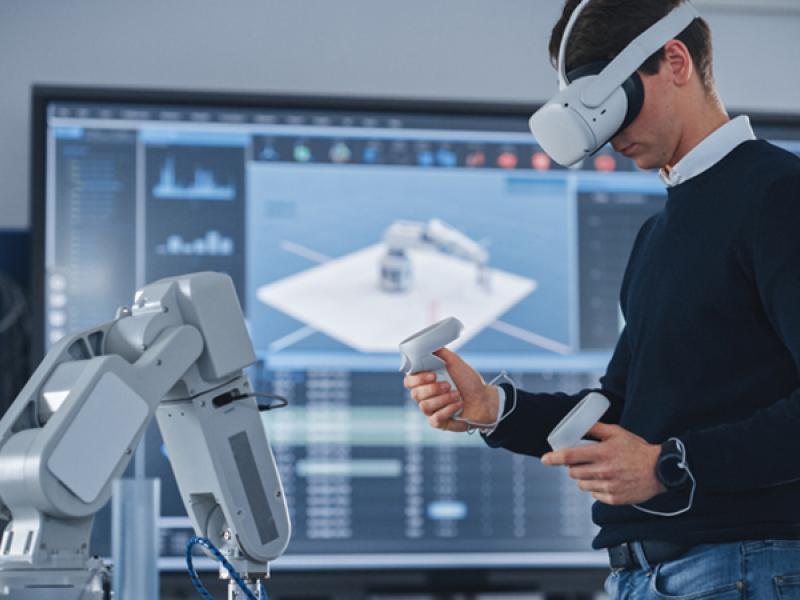Collaborative Robots leaders and practitioners share insights on future-proofing manufacturing in Asia Pacific
October 6, 2020 – Universal Robots, the global leader in collaborative robots (cobots), has successfully completed the first “Meet the Cobot Leaders” session in Asia Pacific, a ‘live’ online interactive congress on cobots and their encompassing role in the future of manufacturing throughout Asia Pacific.
Leading cobot luminaries, Mr Jürgen von Hollen, President of Universal Robots, Mr James McKew, Regional Director of APAC, Universal Robots, and Dr Che Fai Yeong, Director of DF Automation and Robotics, expounded industry insights and answered important questions from industry practitioners and attendees online, with visionary and practical insights on post-pandemic manufacturing, and how manufacturers in Asia Pacific can be future-ready.
COVID-19 - the game changer
The COVID-19 crisis in 2020 exacerbated existing challenges and exposed new vulnerabilities for manufacturers around the world.
The serious disruption to supply chains, sudden material shortages, and steep swings in demand left manufacturers grappling with changes. Labour-intensive manufacturing has been hit painfully by the regional governments' COVID-19 measures of extended lockdowns and social distancing. But such measures present an opportunity for labour-centric manufacturers to rethink their operations, on ways to keep production going while adhering to regulatory measures, without sacrificing cost efficiency, and to future-proof operations for more resilience. The event converged the luminaries and attendees with a lively exchange of ideas and recommendations.
According to the panel, COVID-19 was a catalyst for further implementation of cobots in applications previously low on the cobot automation radar - in particular medical applications such as swab testing, sterilisation and disinfection. One such example was the disinfecting of aircraft seat arm rests where it makes sense to use cobots rather than have humans carry heavy apparatus. It avoids repetitive strain injuries and ultimately even possible infections.
Opportunities and challenges of our time
There was also a common agreement that one of the biggest opportunities for UR market development was with smaller manufacturers. Jurgen mentions that UR recently celebrated their 15year anniversary. The company started when its founders realised the limited automation possibilities for SME’s. Today nearly half their customer base is large companies who were quick to understand and adopt cobot automation but yet the SME’s still feel it is only meant for bigger players.
James agreed with this notion highlighting that the biggest challenge they see is small business being scared off by cost and how to yield return on investment. They need to understand the investment and what this ultimately will bring to their organisation.
This is where the UR team focuses a lot of their attention. Understanding the needs and business objectives of these small businesses and helping them identify and implement their cobot opportunity.
COVID has been good at helping customers understand the benefits of cobots by helping them automate dumb, dirty and dangerous jobs and very importantly, helping them to distance and do this without the need for an increased footprint.
ROI and investment considerations
“UR delivers incredible ROI that will satisfy every financial decision maker. Being able to have a conversation about how cobots allow a distinct benefit in labour variability and managing the high cost of poor quality” says James.
Even countries who are highly price sensitive with a volatile exchange rate such as India and Indonesia have shown that cobot implementation makes financial sense.
Price isn’t the barrier according to the UR as customers in lower performing economies and the more than 46 000 cobots installed worldwide have proven. Understanding the full value of the flexibility offered by cobot automation is the key to higher uptake.
Jurgen mentions that cobots are the disrupters of the automation world. It offers customers the flexibility which is the key to business continuity - now more than ever before. It enables a customer to deploy and redeploy a cobot over and over again for every application with minimal disruption. The customisation provided by the UR+ partners are a critical component to business continuity. “A customer should be able to continue producing, as they did today, tomorrow and the next day, regardless of circumstance.”
“The key success factor for any company right now is flexibility. As CEO we are going through same pain to forecast what is happening in 3 or 6 months. To be flexible and dynamically adjust your infrastructure to meet customer needs is fundamentally important. COVID has made us realise that business continuity is a huge requirement and that we have to always look at it critically and question it” says Jurgen.
Are robots replacing humans?
On robots replacing humans, the answer is clear. The COVID-19 pandemic has resulted in many layoffs. With people now more worried about job security than ever, companies may face hesitancy at the adoption of further automation. Jurgen pointed out that statistically countries with higher levels of automation and cobot implementation had the lowest rate of unemployment according to pre-COVID studies.
Cobots are not there to replace humans and according to him the UR perspective is that the most effective and efficient system is one that combines human and robot.
James points out that cobots help manufacturers to reopen by taking care of the dull, dirty and dangerous tasks while managing distancing on the factory floor. Without these measures business will remain closed and will face even further financial losses - resulting in further job cuts or ultimate closure.
“With cobots you are ensuring business continuity and you have the capability to work despite a virus or social distancing. As the world becomes more chaotic and unpredictable, humans will become even more irreplaceable” concludes Jurgen.
Conclusion
In conclusion Jurgen comments that running a business is about managing risk. “The worst decision is no decision” he says in closing.
Dr Yeong, a name well-associated with robotics and inventions in Malaysia, and a winner of more than 100 awards nationally and internationally, moderated the session. Dr Yeong said after the successful completion of the conference, the cost of non-deployment is ultimately the highest price to pay.
About “Meet the Cobot Leaders”
“Meet the Cobot Leaders” is part of “WeAreCobots APAC”, the first collaborative robots virtual expo in Asia Pacific, hosted by Universal Robots. From 6 to 8 October 2020, participants gain enriching insights from automation experts on overcoming manufacturing challenges in APAC
Highlights include:
- 3 Live Days, 6 to 8 October 2020
- Online session available on demand from 9 Oct - 7 Nov 2020
- 9 UR+ partner exhibit booths
- 15 keynote presentations by automation experts
- 45 live demonstrations
- 100+ documents available for download
- 100+ automation professionals ready to answer your questions
Register to attend at https://wearecobots.apac.vfairs.com/
Image:
Mr Jürgen von Holler - President - Universal Robots






